Luxury Travel Review

Our Artisanal Dark Chocolate Tasting
Article by Margot Liebman
Photos by Aaron Lubarsky*
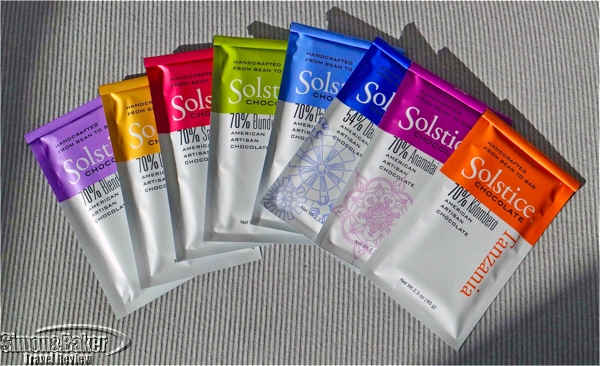
The selection of Solstice bars I tasted.
When a small box appeared in the mail one afternoon in late December, I was pleasantly surprised. Inside were eight sleek bars of chocolate from Solstice Chocolate, a premier American artisan chocolate maker in Salt Lake City, Utah (Solstice Chocolate, Inc., 469 West Century Drive, Salt Lake City, Utah 84123, +1- 801-871-5935, www.solsticechocolate.com, info@solsticechocolate.com). Each bar was dressed in a smooth, thick paper and foil package that resealed at the top to keep the chocolate inside fresh; and color coded with bold type indicating its origin, cacao percentage, and brand name.
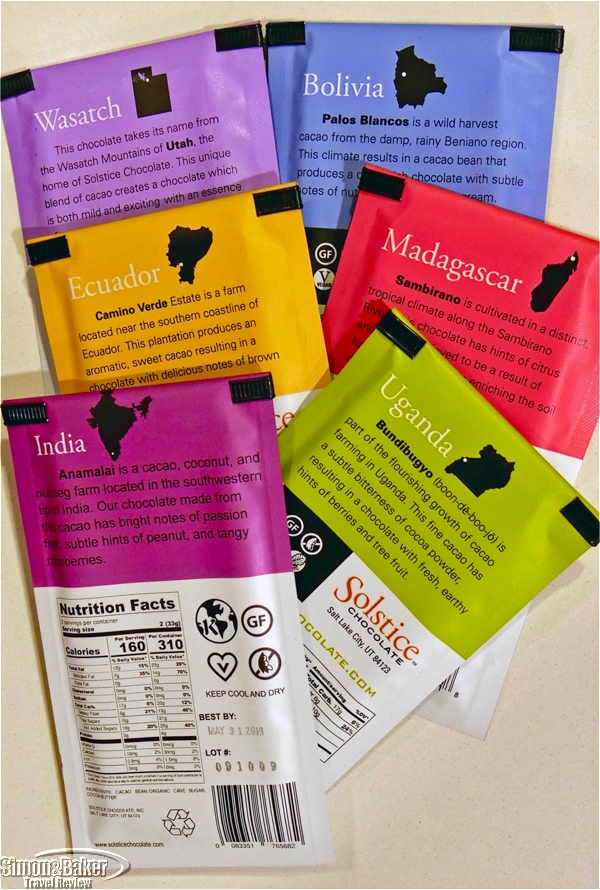
The packaging described the source of the cacao beans used to make it.
The Solstice website, describes its products as a “bean-to-bar chocolate” that is handcrafted using the finest single origin cacao from all over the world. With names like India, Madagascar, and Tanzania, it was easy to know where a bar’s beans originated. I imagined that each bar would taste quite different, but quickly learned that the differences were subtle. From bean delivery to getting packaged bars out the door Solstice allotted between seven and ten days for production.
“Our chocolate is known for having bright flavors. Our origin varieties range from fruity to earthy; there’s something for everyone,” said DeAnn Wallin, owner, Solstice Chocolate when asked by email what distinguishes Solstice products from those of other chocolate makers. “Our bars stand out, each having its own personality, so to speak, and each can be distinguished from the others. Our style is also reflected through uncluttered packaging with bold colors.”
As a milk chocolate lover, it took me a while to appreciate the dark, intense flavor of the Solstice Chocolates. Most of the bars tasted earthy and bitter, and were almost waxy in consistency. Save the one bar of milk chocolate, all the bars boasted 70 percent cacao. That said, it was fascinating to savor the different notes in each bar, and to think about the harvesting conditions that must play a role in how the beans grow.
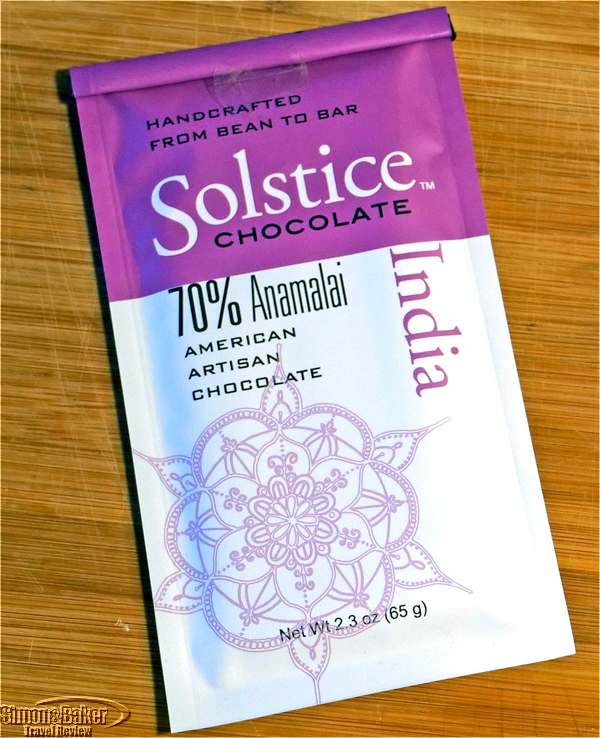
The bars displayed the percentage of cocoa.
I first tasted Uganda, which had a bitter tone that left hints of berries on my palette. Second I sampled Ecuador. When I looked on the Solstice website, I saw that Ecuador was handcrafted from cacao grown by Camino Verde Estate, a farm located near the southern coastline of Ecuador with an unusual fermentation method. It was a strong flavor, with sweet aromatics and hints of banana and cream. The next one was Bolivia. At first bite, a wave of nostalgia rushed over me. I quickly realized the bar reminded me of baking chocolate. It tasted of honey, nuts, and favorite memories of making chocolate desserts.
When asked how her company selects the beans Wallin replied, “Networking through trusted sources. We receive cacao samples on a regular basis. If one interests us then we test it, research it and decide if we want to invest in using it.”
Tanzania was fruitier, smoother and a bit more tart than the previous bars. Wasatch was exciting, and had an unexpected spiciness. India was more complex than some of the others, with tangy flavor notes and hints of earthy spice. Madagascar was more of a slow experience, as most of the flavors came to me a few moments after the piece had already melted on my tongue. There was a strong citrus tone, and when I looked at the Solstice website I learned that those flavors are believed to be a result of former fruit plantations enriching the soil during French Colonial times.
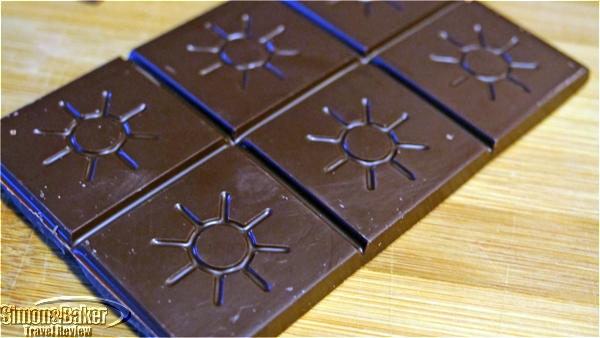
The bars were molded with a sunburst shape in the center of each square.
For my last delicious morsel, I saved the milk chocolate. The package indicated that the bar was 54 percent cacao, where the dark chocolates were 70 percent cacao. The flavor was denser, and not as milky in texture as other milk chocolates I have sampled. I tasted subtle hints of graham cracker, but that may have been wishful thinking for a s’more.
Solstice Chocolate bars were lovely to look at. The packaging employed a celebratory color palette, and each bar was clearly labeled. A white dot on the country of origin map on the back of the package indicated where the beans were farmed. Knowing where the beans were sourced helped me enjoy the chocolate bars in a different way. I found myself looking for subtleties and thinking about the story of each chocolate in an interesting way. Based on my experience, I would recommend Solstice Chocolate to my friends who like dark chocolate.
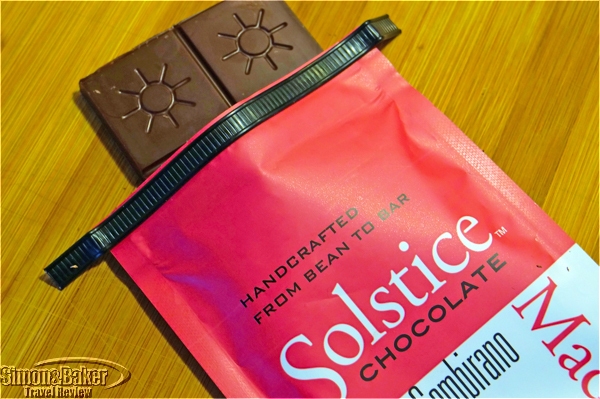
The packaging included a closure to reseal it after opening.
Editor’s note: We asked two of our contributors who are dark chocolate lovers to sample Solstice chocolates in February 2018 as well. Here is what they found.
We compared the Solstice Chocolate Madagascar 70 percent Sambirano, a 2.3 ounce bar, with a well-known premium European dark chocolate bar with a similar cacao content and were stunned by the difference in the two. We blended each with hot water and tasted them side by side. Where the hot drink made from the European bar was almost lumpy in texture, had a milky undertone and muted flat flavor the Solstice hot drink was smooth in texture and taste, with a layered tart flavor that was rich with just a hint of pleasant bitterness. It remains memorable after several weeks.
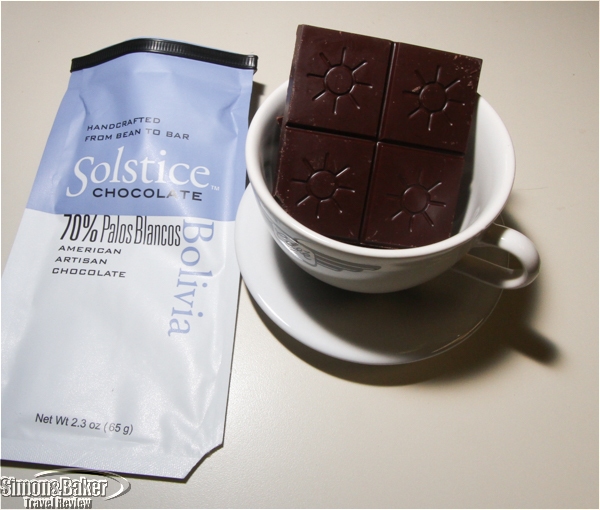
Melting the chocolate into a couple of ounces of hot water created a delectable drink.
We also liked the Bolivia 70 percent Palos Blancos, which came in a 2.3 ounce bar. For a contrast we also sampled the Solstice Chocolate Coconut American Artisan White Chocolate, a 2.2 ounce bar. The coconut burst through immediately past the sweet and buttery texture of the butter colored pieces to become an instant favorite.
We appreciated the simplicity of the ingredients. The Sambirano and Palos Blancos ingredients were organic cacao bean, organic cane sugar and organic cocoa butter. The white chocolate was made with cocoa butter, whole milk, organic coconut, organic cane sugar, and pure vanilla extract.
*The final photo is by Gary Cox.
Vehicle Signal Booster Overcame Cellular Dead Zones
Article and photos by Gary Cox
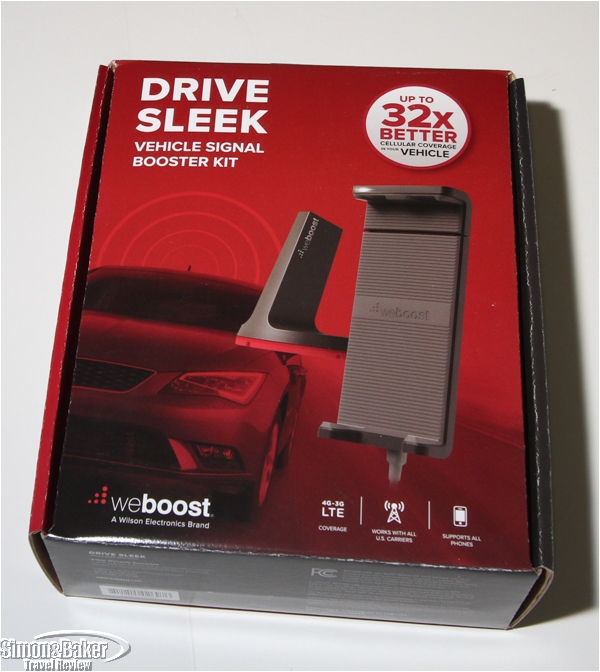
The weboost Drive Sleek Vehicle Signal Booster Kit
Cellular reception in Palm Beach County, Florida for our carrier varies from great to non-existent as we drive around during the course of a weekend, running errands and visiting the beach. Dropped calls are common, and there are places where the signal is so weak that a call cannot be completed. That was why we took advantage of the opportunity to try out the new Drive Sleek Vehicle Signal Booster Kit from weBoost (3301 E. Deseret Drive, St. George, Utah 84790, +1-866-294-1660, https://weboost.com, support@weboost.com). The .55 pound device was designed and assembled in the United States with foreign parts, according to the box.
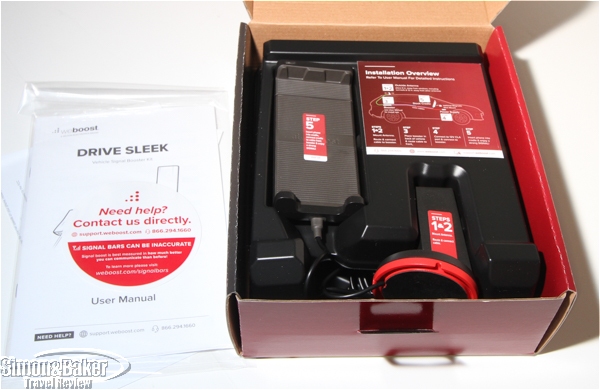
The box contained a detailed manual and a number to call for help.
Our kit contained an antenna with a magnetic base, a signal booster, a 12 volt power plug, a cradle for the phone and the cables to connect them together. The parts were labeled with numbered stickers that designated the installation procedure. I placed the antenna on the rear deck of our mustang convertible and ran the cord into the trunk. The booster’s Velcro like attachment and some cable wraps made it simple for me to affix it to the lining in the trunk behind the backseat. I was able to fit the cables up and around the seat, tucked out of the way for the most part, except for the jump to the center console where the power plug resides.
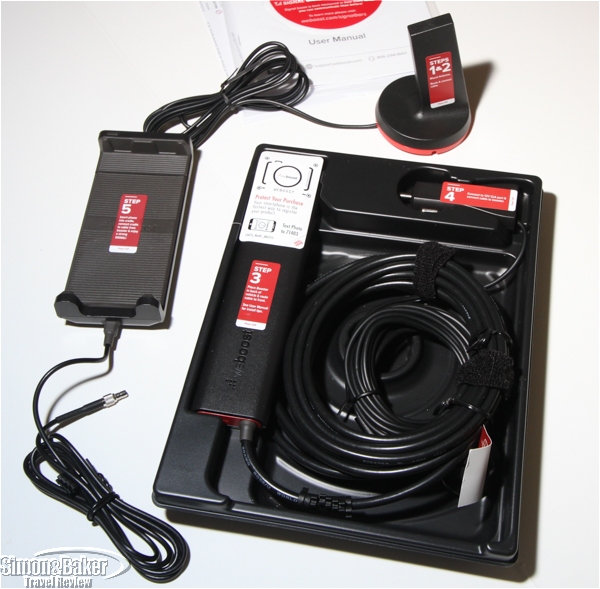
The components had numbered stickers showing the installation order.
The cradle came with an attachment to fit the vents on some cars, but was just not practical in the vents on the mustang. The vent mounting (a little split cone with a magnetic back) helped keep the cradle from sliding off the center console. The cone on the back of the cradle fit into a cup holder and stayed put under normal driving conditions. The power plug must be disconnected when not in use as it continues to draw power even without the car running. A light on the cradle indicates that it is powered up. I prefer to unplug it rather than risk that in a rush I might leave it hooked up and return to a dead battery. It is not clear how long it would take to run the battery down.

The magnetic antenna mount held securely between the trunk and the soft top
As soon as I placed a phone in the cradle, the effect of the booster was visible in the number of signal bars on the display. A hands free, either Bluetooth or wired is necessary for comfort and according to the user manual. The Federal Communications Commission (F.C.C.) requires that users never hold the device in the cradle up to their ears. Some local municipalities require the use of a hands free headset from drivings using a mobile phone. Our iPhone has the hands free jack on the top, so it had to be inserted into the cradle upside down. Once there it then remained in the spring loaded slot. After several trials with the new configuration, we managed to maintain calls while driving across the county without any drops or loss of signal, and the mobile phone worked in what previously were dead zones.
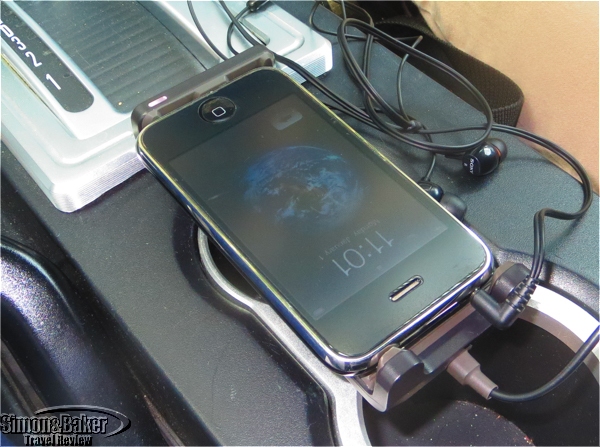
The phone secured in the cradle with the hands free cable attached.
According to the manufacturer, the boosted signal will extend battery life, which makes sense although we did not test it as a specific benefit. More than anything, it was nice to use the phone and maintain a conversation while running our errands or traveling, and reassuring to know that if we had an emergency or car trouble (other than a dead battery), we would be able to make a call even in the former dead zones. We have been satisfied with weBoost Drive Sleek Vehicle Signal Booster Kit and would recommend it to friends looking to increase the mobile phone signal in their cars.
Happy New Year!
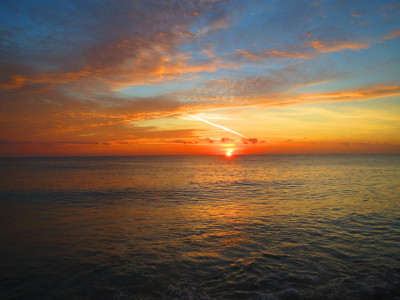
May your New Year be healthy, happy, and prosperous, and offer you rewarding experiences wherever you go!
Our French chocolate tasting in Manhattan’s Upper East Side
Article by Margot Liebman
Photos by Aaron Lubarsky
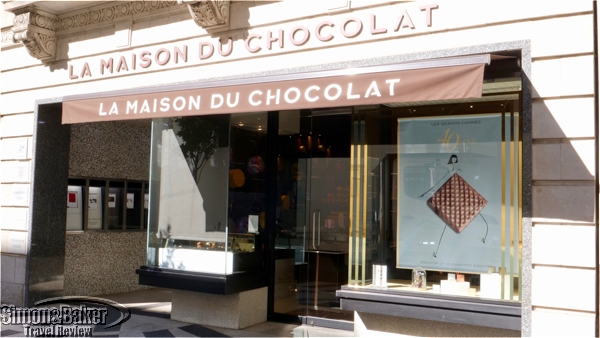
La Maison du Chocolat Madison Avenue store
We thought we knew chocolate until we tasted some of the products of La Maison du Chocolat (1018 Madison Avenue, New York, NY 10075, http://www.lamaisonduchocolat.us/la-maison/en_us, +1 718 361-9161), a French company. At the time of our tasting, in addition to locations in France and several in New York City, the company had shops in China, Japan, Korea, Kuwait, Macau, and United Kingdom.
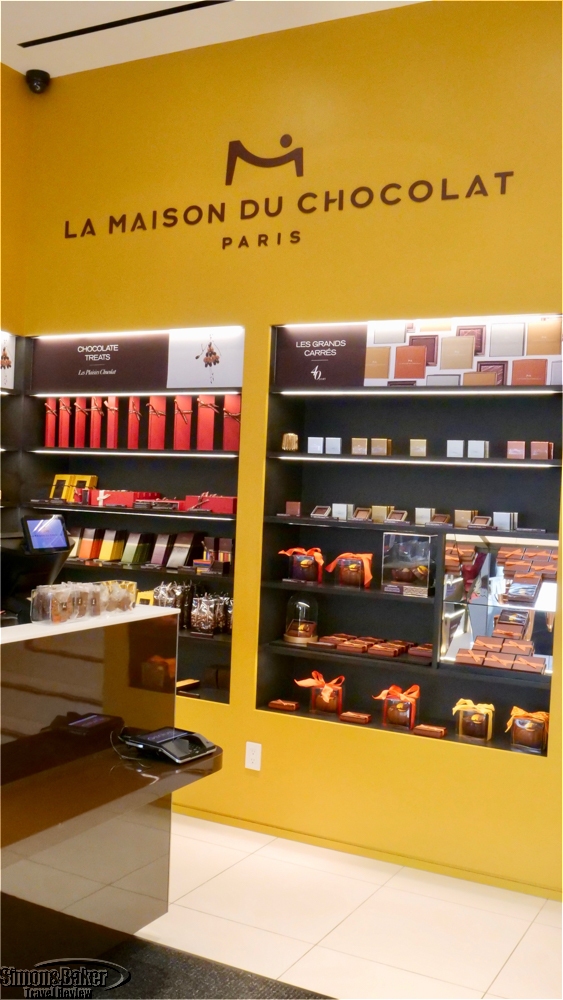
Inside the Madison Avenue store
We arrived on a cool, sunny morning in mid-October as the Madison Avenue store was opening. The city was just waking up, with people on their way to work and the streets starting to fill with the daily bustle. Located in an upscale neighborhood, La Maison du Chocolat’s boutique shared a block with prestigious clothing stores and cafes. During our visit, we each tasted six chocolate truffles, one macaron and two types of hot chocolate. We returned home with a box of six macarons (meringue and almond flour confections).
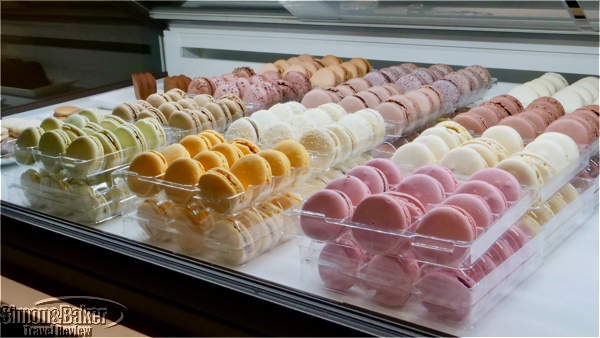
Macarons on display
At the front of the store shelves displayed various chocolate collections in signature dark brown boxes. There was also a counter with individual chocolates, as well as fresh pastries laid out in the window. The shelved collections of chocolate were organized by individual lines, including: Truffles, Maison Icons, Pralines, Chef’s Creation, Grand Carrés, Chocolate Treats, and the 40th Anniversary line. One of the friendly staff explained that the Maison Icons are the best selling line because they are the most well known, and come in boxes that may be customized.
The shop had the understated aesthetic we expected from a chocolatier: dark brown boxes, neatly organized chocolate truffles on display, and minimal decorations on the walls. In the back of the store there was a small café where we sampled six square chocolate truffles arranged in order of darkness. I started with Akosomno, the darkest chocolate. It was deep and smooth, and revealed an unexpected spicy note at the end. Next was Caracas, a bolder experience and by far the most intense. Boheme, the third on the plate, was the perfect harmony between milk chocolate and dark, the two notes came in and out as it melted on my tongue. I normally do not favor chocolate mixed with fruit, but Salvador was an exception. The dark chocolate mixed with an acidic raspberry ganache (a filling made from chocolate and cream) was tangy and exciting. Crystal touched all the notes evenly for a perfect flavor: it was a delicate blend of crispy, sweet, nutty praline wrapped in silky milk chocolate, finished with a touch of sea salt. Lastly, Grain Dentelle’s milk chocolate blended caramelized nuts and crispy pieces of crepes for a subtle, crunchy texture.
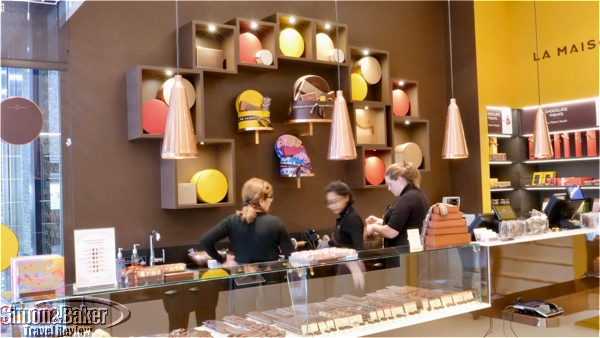
Busy staff behind the counter
It was early in the morning when we tasted the truffles, so we tried to restrain ourselves. We were unsuccessful. The chocolates were so rich and delicious, we ate most of what was on our plates.
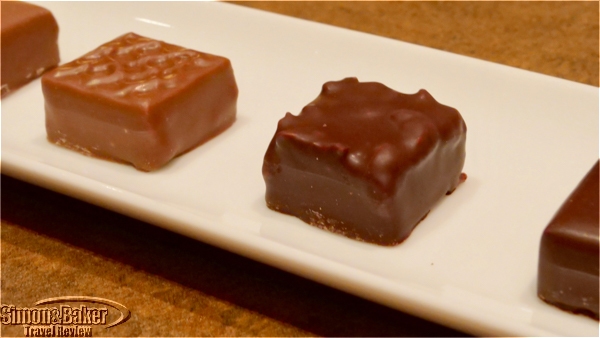
We sampled six chocolate truffles
We tried two types of hot chocolate. Guayaquil was like the luxury version of my childhood hot chocolate. It was creamy and sweet, but grounded by the gravitas of fine chocolate. Caracas was an unexpected experience for me. It had a full-bodied flavor with a light texture.
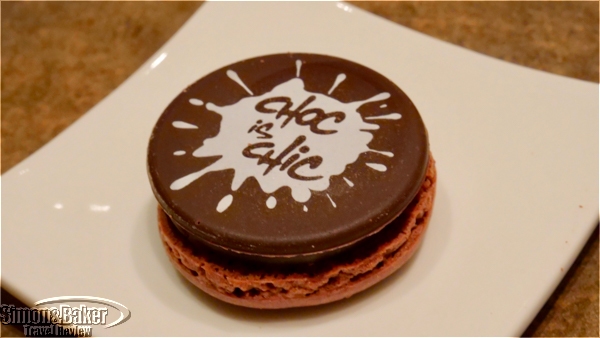
La Maison du Chocolat’s 40th anniversary limited edition macaron
We also sampled a La Maison du Chocolat’s 40th anniversary limited edition macaron, which was filled with dark unctuous ganache and subtle passion fruit within a thin and crunchy chocolate disk and soft, chewy cookie.
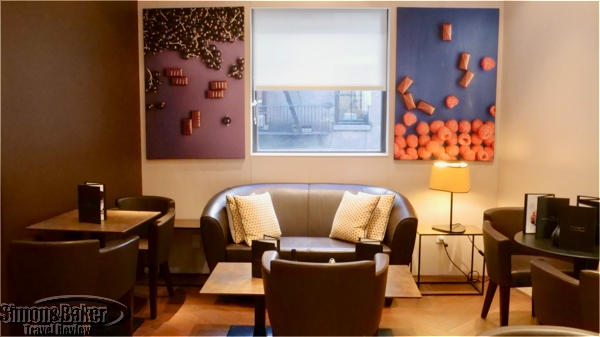
In the cafe in the back of the store we sampled six chocolate truffles arranged in order of darkness
As we indulged in the tasting, the staff recounted the story of La Maison du Chocolat, and the reasons they believe their chocolate is so special. Rami Sarabi, country manager, told us that ganache is the secret. Robert Linxe, who founded La Maison in 1977, was known as the “Sorcerer of Ganache.” Linxe insisted on making chocolate the old-fashioned way, which takes three days, according to Sarabi. The result, he said, should be a perfect balance between silkiness and richness. We found this to be true. The flavors came in waves as the ganache melted, making for a layered and sophisticated experience.
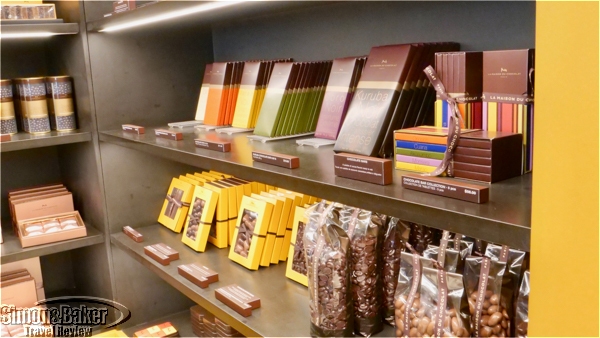
One of the display cases
Before Linxe passed away, he appointed his protégé, Nicolas Cloiseau, head chef. Today, Cloiseau oversees over thirty chefs. According to the staff, the chocolate on sale at the company shops was made in France following meticulous, traditional methods, and shipped to the various stores around the world.
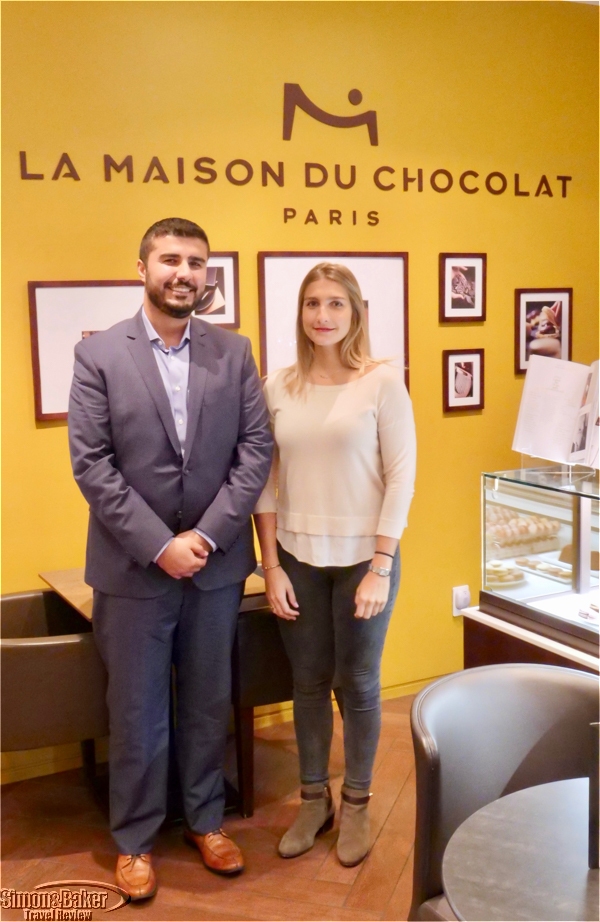
Rami Sarabi, country manager, and Eva Rousseaux, manager, Marketing
We were pleased to learn from Rami that all of the cocoa in the shop was from sustainable sources. The staff reported that they could trace each piece of chocolate back to the exact location from which the bean was harvested. We tasted three macaron flavors, Quito, Maracuja, and Rigoletto. Each macaron, we were told, was made in France and shipped to the various stores worldwide. The ones we sampled were not refrigerated. After a week on our shelf they remained fresh. The wafers were soft with a chewy texture, and melted on the tongue.
Quito was an airy and sweet milk chocolate wafer, a perfect compliment to the dark chocolate ganache. The passion fruit of the Maracuja macaron was tangy, its tropical tones highlighting the deeper notes of the ganache. The Rigoletto brought me back to a traditional flavor, with the middle-sweetness of caramel. In addition to being delicious, the macarons looked delightful lined up together.
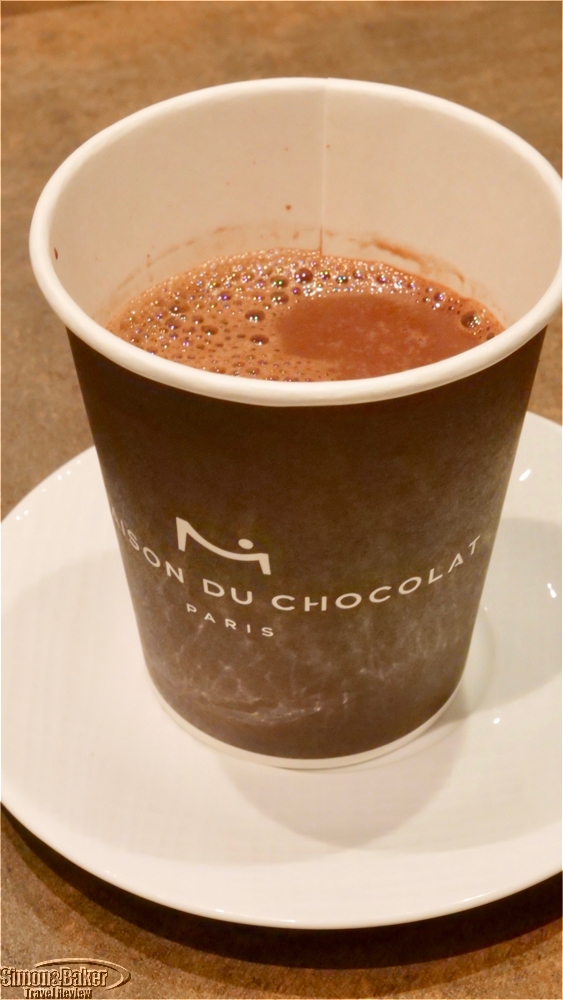
Our hot chocolate was served in disposable cups.
We loved the rich taste and high quality of the chocolates at La Maison du Chocolat, as well as the luxurious experience of the boutique itself. We plan to return to the shop, sit in the café, close our eyes, and be swept away by the complex flavors.
New book highlights craft chocolate, shops, makers
By Elena del Valle
Photos by Gary Cox*
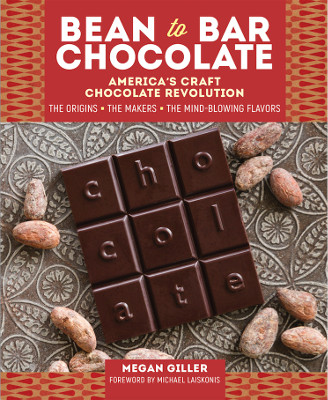
Bean to Bar Chocolate by Megan Giller
I have had chocolate in a number of forms and locations ranging from exotic and improbable such as a safari lodge and mundane such as my kitchen. I have sampled supermarket milk chocolate bars and dark chocolate gourmet bars, foreign and domestic. Over the years my preference has migrated from garden variety milk chocolate to the more flavorful options offered by specialty brands and artisan vendors. For some time I have been a fan of single origin chocolate bars, especially the plain dark chocolate ones layered with flavors.
My most recent chocolate experiences were enhanced manifold by Bean to Bar Chocolate America’s Craft Chocolate Revolution (Storey Publishing, $19.95), a new book by Megan Giller. Thanks to her detailed descriptions, I became much more aware of the diversity of the domestic craft chocolate movement and dozens of bean to bar makers. The 231-page hardcover book published this year features color photos, color illustrations and chocolate recipes.
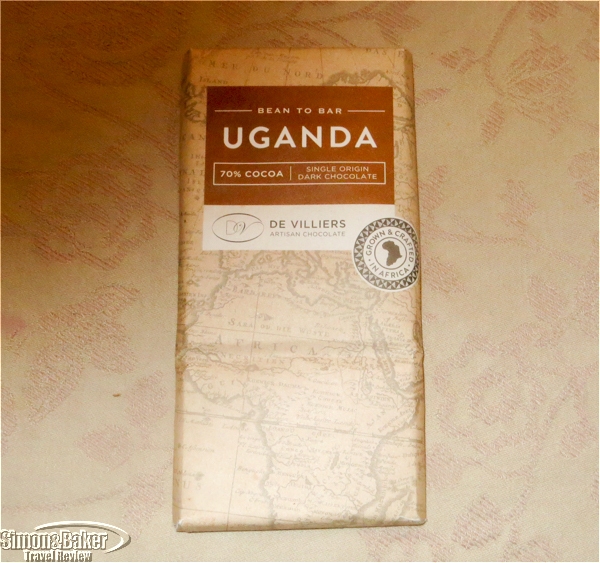
Bean to Bar chocolate from Uganda grown and crafted in Africa
My favorite part of reading her book was the gourmet experiences that followed from preparing her recipe for Water-Based Drinking Chocolate (from Aubrey Lindley, co-owner, Cacao). I also tried the Cocoa Tea (from Miss Choco) made with roasted nibs and water, although that was less to my liking. Once I procured the chocolate bars the Water-Based Drinking Chocolate was a cinch. Like the Cocoa Tea the recipe calls for only two ingredients, chocolate (or roasted nibs) and boiling water.
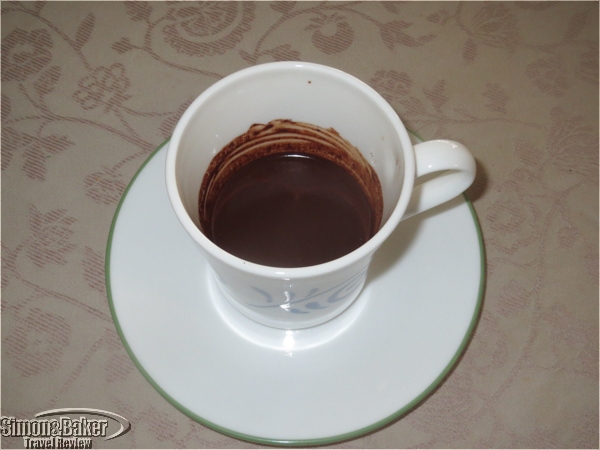
A few ounces of chocolate melted in a little hot water highlighted the qualities of each type we tasted.
For the Water-Based Drinking Chocolate we sampled four chocolate bar varieties, an organic and sustainably produced bar purchased at the supermarket; a bean to bar 70 percent single origin from Uganda made by De Villiers Artisan Chocolate near Paarl, South Africa; and a half and half blend (all we had available were partial bars) of single origin bean to bar Honduras The Lost City 72 percent and Dominican Republic Duarte 70 percent from Castronovo Chocolate from Stuart, Florida.
The beverage made with the supermarket bar was so awful we threw it out without finishing the serving. The Ugandan beverage tasted better although it was lumpy and had a medium to mild flavor, nothing extraordinary. The texture, even after whipping it twice with a small whisk, was lumpy. In defense of the makers it was past its expiration date. It was a good thing that we first tried the recipe with the Castronovo chocolates because we might not have sampled further otherwise.

The Castronovo chocolate bars were our favorites for the chocolate beverage.
The Castronovo blend was delightful, dark and rich with a hint of smokiness and flavors that lingered on the palate. Later, I bought more of the Dominican Republic Duarte, my favorite of the two available at the small shop where I purchased them, planning another Water-Based Drinking Chocolate made with those bars. Also, I want to sample more domestic bean to bar chocolates and plan tastings, maybe even try some of the other recipes in the book.
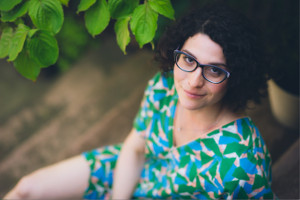
Megan Giller, author, Bean to Bar Chocolate
Giller, a Brooklyn resident, is a food writer, specializing in New York City and Austin, Texas. She writes Chocolate Noise, a blog. Giller’s chocolate knowledge shines throughout the book and her enthusiasm is contagious. She shares information on the craft movement, the people behind the chocolates from the farms to the makers and their approach to purchasing cacao beans, roasting, processing and making mostly single origin chocolate, mainly with only a limited number of ingredients. She also addresses history, equipment, labels, sustainable practices and pricing. There is a list of her favorite bean to bar makers in the back of the book.
*Book photos: Storey Publishing
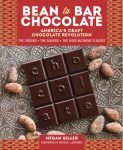
How big and beautiful cinema camera bag performed on the go
Article and photos by Aaron Lubarsky
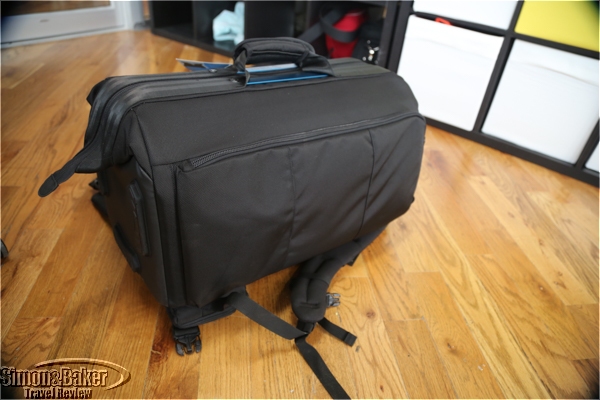
The Cineluxe Backback 24
The Cineluxe Backback 24 by Tenba (Tenba, 75 Virginia Road, North White Plains, New York 10603, +1 914 347 3300, www.tenba.com, info@tenba.com) is a simple, large, lightweight backpack bag, made in China, designed for professional cinema cameras and electronic news gathering (ENG) rigs. On the road it was a non-nonsense, durable, weather-resistant bag that solved a specific problem: how to best carry a large fully built (with all the camera components assembled) camera rig on my back.
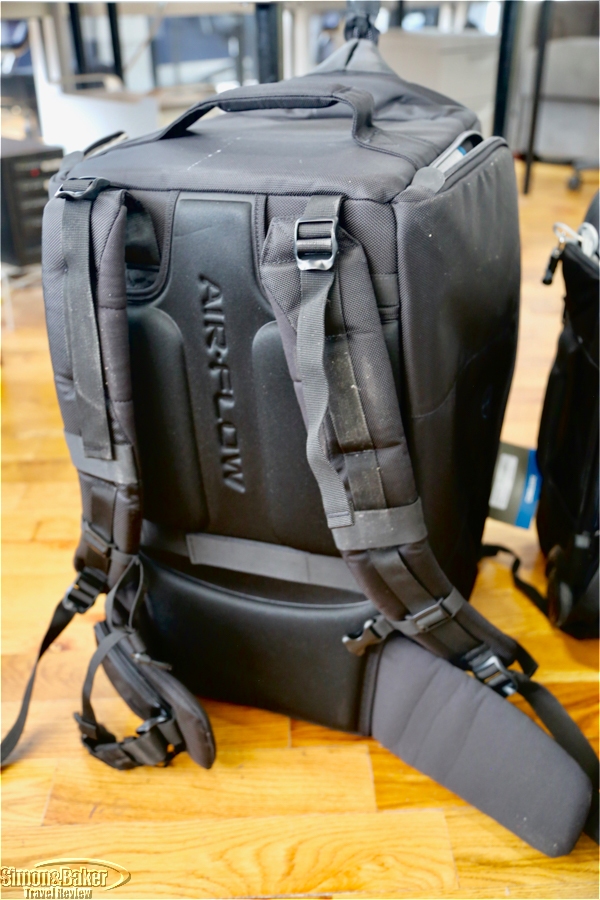
The backpack straps
It improved my efficiency in the field. The doctor bag style opening was a refreshing design innovation, allowing the camera to remain fully assembled and ready to go, which is a huge convenience for run-and-gun style filming or when time is a factor.
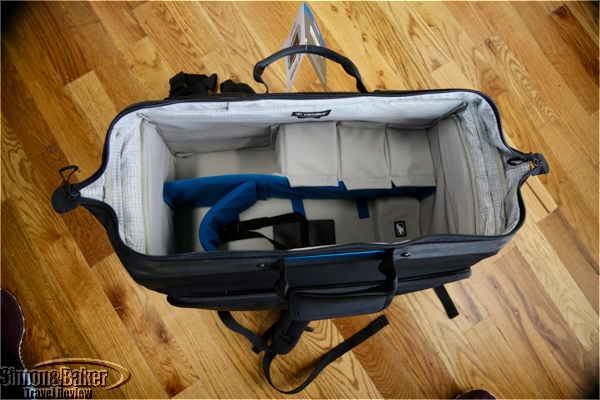
The interior of the Tenba Cinelux Backpack 24
The bag is large (13.5 wide by 24 tall by 14.25 deep, inches), but surprisingly nimble. Weighing eight pounds it was practical for quick moves from location to location, thanks to a comfortable harness and straps, and weathered tough conditions thanks to a body armor base panel.
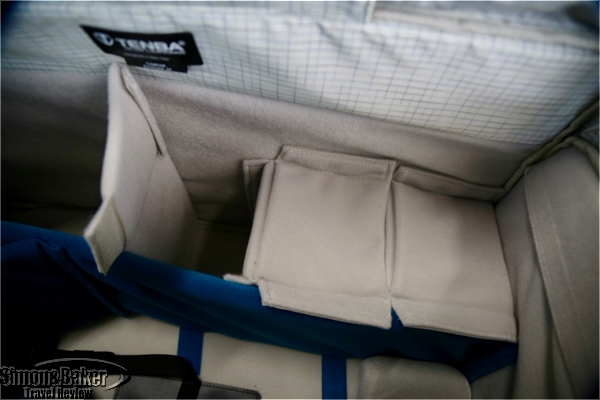
A closer look at the compartments
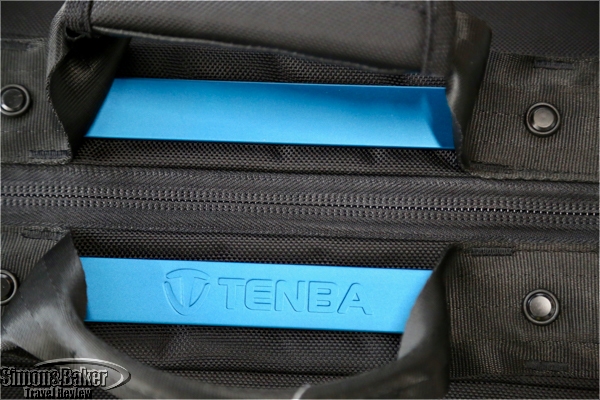
The handles are reinforced
The two side pockets didn’t open entirely because they were designed to hold shotgun mics, matte boxes, and flags. For that purpose they performed well, but there wasn’t an easily accessible pocket for small items like my wallet or cellphone. It’s not that kind of bag.
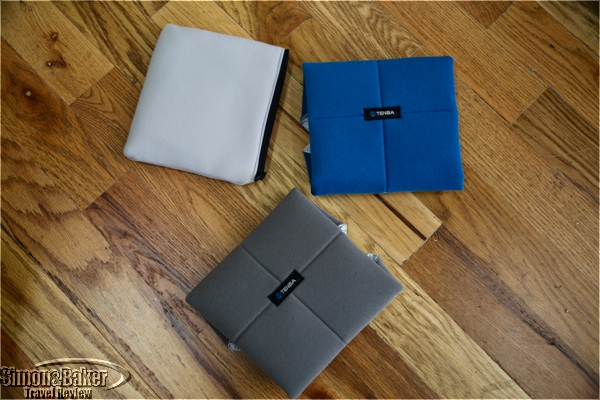
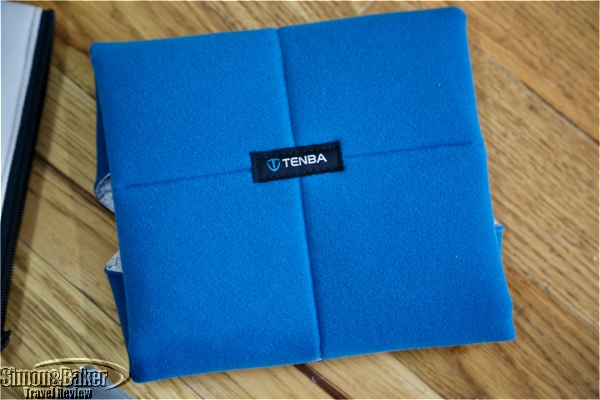
Color coded padded wraps
And it’s not the kind of heavy, solid bag I would check-in at the airport or load up with lots of accessories. It is too big for lean and small camera set-ups. It has the elegant touches I have liked on other Tenba bags, including attractive blue metal bands engraved with the Tenba name and a leather trimmed handle.








